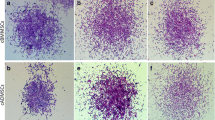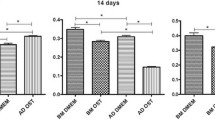Abstract
The annual regrowth of deer antlers is a connatural developmental event in mammals. Therefore, studying regeneration of deer antlers could be a unique natural model of rapid and complete bone regeneration in human and other mammals. However, little is known about culture conditions and regulatory factors that stimulate growing of deer antler cells in vitro. The aim of this study was to enhance an in vitro culture efficiency of mesenchymal stem cells (MSCs) derived from deer antlers. In order to improve the culture condition, we selected minimal essential medium alpha (MEMα) as a basal medium and investigate whether serum could stimulate growing in these cells in basal medium in a dose-dependent manner. Next, to investigate the optimal temperature and O2 tension, the antler cells were cultured in different temperature and controlled O2 percentages. Through the results of number of harvested cells after 1 week, we selected MEMα, 10% fetal bovine serum (FBS), 37°C, 20% O2, and 5% CO2 tension as a basic culture conditions. Also, we could observed enhanced proliferation results by addition of the supplements [L-glutamine 2 mM, β-mercaptoethanol 100 μM, non-essential amino acid (NEAA) 0.1 mM, and HEPES 10 mM] and growth factors [basic fibroblast growth factor (bFGF) 10 ng/mL, epidermal growth factor (EGF) 20 ng/mL, insulin-like growth factor-1 (IGF-1) 10 ng/mL] and harvested antler cells strongly expressed STRO-1 and CD 90. Our results demonstrate that allow continuous proliferation of antler cells in vitro established the foundation to basic biology of antler cells and makes possible application to the regenerative medicine in a broad sence.
Similar content being viewed by others
References
J Price, C Faucheux, S Allen, Deer antlers as a model of mammalian regeneration, Curr Top Dev Biol, 67, 1 (2005).
P Muir, A Sykes, G Barrell, Growth and mineralisation of antlers in red deer (Cervus elaphus), New Zeal J Agr Res, 30, 305 (1987).
HJ Rolf, U Kierdorf, H Kierdorf, et al., Localization and characterization of STRO-1 cells in the deer pedicle and regenerating antler, PLoS One, 3, e2064 (2008).
C Li, W Wang, T Manley T, et al., No direct mitogenic effect of sex hormones on antlerogenic cells detected in vitro, Gen Comp Endocrinol, 124, 75 (2001).
L Bartos, D Schams, U Kierdorf, et al., Cyproterone acetate reduced antler growth in surgically castrated fallow deer, J Endocrinol, 164, 87 (2000).
L Bartos, D Schams, GA Bubenik, Testosterone, but not IGF-1, LH, prolactin or cortisol, may serve as antler-stimulating hormone in red deer stags (Cervus elaphus), Bone, 44, 691 (2009).
M Sadighi, S Haines, A Skottner, et al., Effects of insulin-like growth factor-I (IGF-I) and IGF-II on the growth of antler cells in vitro, J Endocrinol, 143, 461 (1994).
M Sadighi, C Li, RP Littlejohn, et al., Effects of testosterone either alone or with IGF-I on growth of cells derived from the proliferation zone of regenerating antlers in vitro, Growth Horm IGF Res, 11, 240 (2001).
HJ Rolf, KG Wiese, H Siggelkow, et al., In vitro studies with antler bone cells: Structure forming capacity, osteocalcin production and influence of sex steroids, Osteology, 15, 245 (2006).
ML Meistrich, ME van Beek, Spermatogonial stem cells. In: C Desjardins, LL Ewing eds. Cell and Molecular Biology of the Testis, NY: Oxford University Press, 266 (1993).
MF Pittenger, AM Mackay, SC Beck, et al., Multilineage potential of adult human mesenchymal stem cells, Science, 284, 143 (1999).
MB Lutz, S Rossner, Factors influencing the generation of murine dendritic cells from bone marrow: the special role of fetal calf serum, Immunobiology, 212, 855 (2007).
NP Rhodes, JK Srivastava, RF Smith, et al., Heterogeneity in proliferative potential of ovine mesenchymal stem cell colonies, J Mater Sci Mater Med, 15, 397 (2004).
K Uchida, K Urabe, K Naruse, et al., Comparison of the cytokine-induced migratory response between primary and subcultured populations of rat mesenchymal bone marrow cells, J Orthop Sci, 12, 484 (2007).
W Pradel, R Mai, T Gedrange, et al., Cell passage and composition of culture medium effects proliferation and differentiation of human osteoblast-like cells from facial bone, J Physiol Pharmacol, 59, 47 (2008).
LA Solchaga, B Johnstone, JU Yoo, et al., High variability in rabbit bone marrow-derived mesenchymal cell preparations, Cell Transplant, 8, 511 (1999).
C Werren, J Diaz-Romero, W Brehm, et al., Influence of culture conditions on expansion and re-differentiation of chondrocytes from horses of different ages, Pferdeheilkunde, 24, 193 (2008).
E Kuzmova, R Kotrba, HJ Rolf, et al., Factors affecting the number of STRO-1+ stem cells derived from regenerating antler and pedicle cells of red and fallow deer, Anim Prod Sci, 52, 746 (2011).
KM Ko, TT Yip, SW Tsao, et al., Epidermal growth factor from deer (Cervus elaphus) submaxillary gland and velvet antler, Gen Comp Endocrinol, 63, 431 (1986).
JG Mount, M Muzylak, S Allen, et al., Evidence that the canonical Wnt signalling pathway regulates deer antler regeneration, Dev Dyn, 235, 1390 (2006).
DK Berg, C Li, G Asher, et al., Red deer cloned from antler stem cells and their differentiated progeny, Biol Reprod, 77, 384 (2007).
C Li, RP Littlejohn, JM Suttie, Effects of insulin-like growth factor 1 and testosterone on the proliferation of antlerogenic cells in vitro, J Exp Zool, 284, 82 (1999).
C Faucheux, SA Nesbitt, MA Horton, et al., Cells in regenerating deer antler cartilage provide a microenvironment that supports osteoclast differentiation, J Exp Biol, 204, 443 (2001).
J Sanchez-Adams, KA Athanasiou, Dermis isolated adult stem cells for cartilage tissue engineering, Biomaterials, 33, 109 (2012).
S Walsh, GR Jordan, C Jefferiss et al., High concentrations of dexamethasone suppress the proliferation but not the differentiation or further maturation of human osteoblast precursors in vitro: relevance to glucocorticoid-induced osteoporosis, Rheumatology (Oxford), 40, 74 (2001).
DL Stocum, Regenerative Biology and Medicine, Amsterdam: Elsevier Academic Press (2006).
DM Gardiner, SV Bryant, Tetrapod li,b regeneration. In: BK Hall ed. Fins into Limbs: Evolution, Development, and Transformation, Chicago: University of Chicago Press, 163 (2007).
PM Barling, AK Lai, LF Nicholson, Distribution of EGF and its receptor in growing red deer antler, Cell Biol Int, 29, 229 (2005).
M Schenker, BM Riederer, T Kuntzer, et al., Thyroid hormones stimulate expression and modification of cytoskeletal protein during rat sciatic nerve regeneration, Brain Res, 957, 259 (2002).
ED Rabinovsky, The multifunctional role of IGF-1 in peripheral nerve regeneration, Neurol Res, 26, 204 (2004).
GA Bubenik, Endocrine regulation of the antler cycle. In: RD Brown, ed. Antler Development in Cervidae, TX: Caesar Kleberg Wildlife Research Institute Kingsville, 73 (1982).
Z Jaczewski, The artificial induction of antler growth in deer. In: RD Brown, ed. Antler Development in Cervidae, TX: Caesar Kleberg Wildlife Research Institute Kingsville, 143 (1982).
JS Price, BO Oyajobi, ROC Oreffo, et al., Cells cultured from the growing tip of red deer antler express alkaline phosphatase and proliferate in response to insulin-like growth factor, J. Endocrinol, 143, R9 (1994).
E Kuzmova, L Bartos, R Kotrba, et al., Effect of different factors on proliferation of antler cells, cultured in vitro, Effect of different factors on proliferation of antler cells, cultured in vitro, PLoS One, 6, e18053 (2011).
C Li, X Gao, F Yang, et al., Development of a nude mouse model for the study of antlerogenesis—mechanism of tissue interactions and ossification pathway, J Exp Zool B Mol Dev Evol, 312, 118 (2009).
C Li, AJ Harris, JM Suttie, Tissue interactions and antlerogenesis new findings revealed by a xenograft approach, J Exp Zool, 290, 18 (2001).
M Nagano, BY Ryu, CJ Brinster, et al., Maintenance of mouse male germ line stem cells in vitro, Biol Reprod, 68, 2207 (2003).
BY Ryu, H Kubota, MR Avardock, et al., Conservation of spermatogonial stem cell self-renewal signaling between mouse and rat, Proc Natl Acad Sci USA, 102, 14302 (2005).
T Ezashi, P Das, RM Rpberts, Low O2 tensions and the prevention of differentiation of hES cells, Proc Natl Acad Sci USA, 102, 4783 (2005).
A Nagy, M Gertsenstein, K Vintersten, et al., A laboratory manual. In: A Nagy, ed. Manipulating the Mouse Embryo, NY: Cold Spring Harbor Laboratory Press, 359 (2003).
N Jaiswal, SE Haynesworth, AI Caplan, et al., Osteogenic differentiation of purified, culture-expanded human mesenchymal stem cells in vitro, J Cell Biochem, 64, 295 (1997).
Author information
Authors and Affiliations
Corresponding author
Additional information
These authors equally contributed to this work
Rights and permissions
About this article
Cite this article
Kim, KJ., Yoo, HD., Kim, YH. et al. Enhancement of in vitro culture efficiency of mesenchymal stem cells derived from deer antlers. Tissue Eng Regen Med 11 (Suppl 1), 16–23 (2014). https://doi.org/10.1007/s13770-013-1124-7
Received:
Accepted:
Published:
Issue Date:
DOI: https://doi.org/10.1007/s13770-013-1124-7




